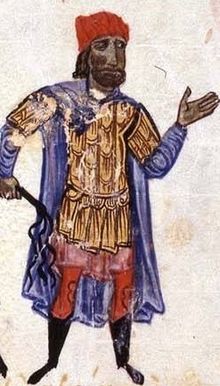| George Maniakes | |
|---|---|
 Maniakes as depicted in the Madrid Skylitzes Maniakes as depicted in the Madrid Skylitzes | |
| Born | c. 998 Macedonia |
| Died | 1043 (aged 44–45) Near Lake Vegoritida, west of Thessaloniki |
| Allegiance | Byzantine Empire |
George Maniakes (Greek: Γεώργιος Μανιάκης; Italian: Giorgio Maniace; died 1043) was a prominent general of the Byzantine Empire during the 11th century. He was the catepan of Italy in 1042. He is known as Gyrgir in Scandinavian sagas. He is popularly said to have been extremely tall and well built, almost a giant.
Biography


Maniakes was a Greek general of the Byzantine Empire, who first came to prominence during a campaign in 1030–1031 when the Byzantine army was defeated at Aleppo, but went on to capture Edessa from the Arabs. His greatest achievement was the partial reconquest of Sicily from the Arabs beginning in 1038. He was aided by the Varangian Guard, then led by Harald Hardrada, who later became King of Norway. Also with him were Norman mercenaries under William de Hauteville, who earned his nickname Iron Arm by defeating the Emir of Syracuse in single combat. However, he soon ostracized his admiral, Stephen, whose wife was the sister of John the Eunuch, the highest-ranking man at court. He then publicly humiliated Arduin, the leader of the Lombard contingent, causing them to desert along with the Normans and Norsemen. In response, he was recalled by Emperor Michael IV, who was also Stephen's brother-in-law. Although the Arabs soon recaptured the island, Maniakes' successes there later inspired the Normans to invade Sicily themselves.


Maniakes' achievements in Sicily were largely ignored by the emperor, and he revolted against Constantine IX in 1042, despite having been appointed catepan of Italy. The person most responsible for inciting Maniakes to revolt was one Romanus Sclerus. Sclerus, like Maniakes, was one of the immensely wealthy landowners who owned large areas of Anatolia - his estates bordered Maniakes', and the two were rumored to have attacked each other in a dispute over land. Sclerus owed his influence with the emperor to his famously charming sister, Maria Skleraina, who had a very positive influence on Constantine in most areas. Finding himself in a position of power, Sclerus used it to poison Constantine against Maniakes - ransacking his house and even seducing his wife, using the charm for which his family was famous. Maniakes' response to Sclerus' demand that he surrender command of the Empire's forces in Apulia was to torture him brutally; sealing his eyes, ears, nose, and mouth with excrement. Maniakes was then proclaimed emperor by his troops (including the Varangians) and marched on Constantinople. In 1043 his army clashed with troops loyal to Constantine near Thessalonica, and although initially successful, Maniakes was killed in the melee after receiving a fatal wound (according to Psellus' account). Constantine's extravagant punishment of the surviving rebels was to parade them in the hippodrome, sitting backwards on donkeys. His death put an end to the rebellion. In Sicily, the town of Maniace and the Syracusan fortress Castello Maniace are named after him.
In popular culture
In the historical drama series Vikings: Valhalla, George Maniakes is played by actor Florian Munteanu. His portrayal in the series is highly fictionalized, with major deviations from historicity. As an example, George Maniakes rebelled against Emperor Constantine IX, not Emperor Romanos as depicted in the series

Notes
- Transliterated as Georgios Maniaces, Maniakis, or Maniaches.
References
- Kaldellis, Anthony (2017-09-14). Streams of Gold, Rivers of Blood: The Rise and Fall of Byzantium, 955 A.D. to the First Crusade. University of Oxford Press. pp. 161–163. ISBN 978-0-190-25322-6.
- ^ Wolf, Kenneth Baxter (2016-11-11). Making History: The Normans and Their Historians in Eleventh-Century Italy. University of Pennsylvania Press. pp. 94–95. ISBN 978-1-5128-0901-5.
But the Greek leader of the expedition, George Maniakes, ...
- ^ Kleinhenz, Christopher (2004). Medieval Italy : an encyclopedia. New York: Routledge. p. 193. ISBN 978-1-135-94880-1. OCLC 62243072.
In 1126 the relics of Saint Agatha were brought back to the city from Constantinople, where the Greek general George Maniakes had taken them a century earlier.
- Byzantino-Nordica 2004: Papers Presented at the International Symposium of Byzantine Studies Held on 7-11 May 2004 in Tartu, Estonia. Morgenstern Society. 2005. ISBN 9949112664.
- Oldfield, Paul (2014-04-30). Sanctity and Pilgrimage in Medieval Southern Italy, 1000-1200. Cambridge University Press. p. 117. ISBN 978-1-107-00028-5.
- Bradbury, Jim. (2004) Routledge Companion to Medieval Warfare. Routledge, p. 65
- Cordero, Rosy (5 May 2022). "'Vikings: Valhalla': Florian Munteanu Joins Cast Of Netflix Series". Deadline Hollywood.
- Tyler, Adrienne (11 July 2024). "Vikings Valhalla Invents Most Of General George Maniakes' Plot, Changing The True Story". Screen Rant. Retrieved 16 July 2024.
| Preceded bySynodianos | Catepan of Italy 1042 |
Succeeded byPardos |